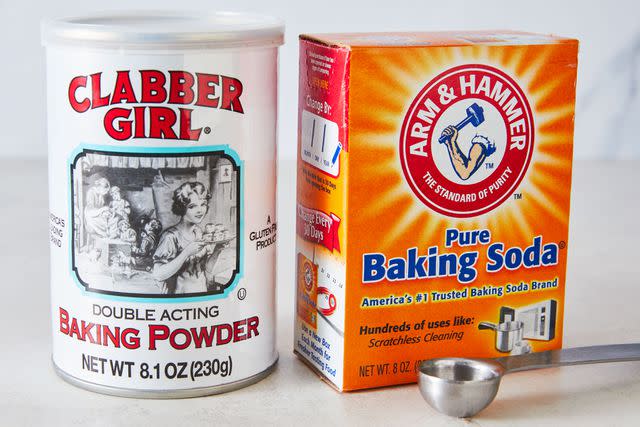Baking Soda Vs. Baking Powder: What's The Difference?
Baking soda and baking powder are common ingredients used in baking and other culinary pursuits, but they are not interchangeable.
Baking soda and baking powder are not the same thing and cannot be used interchangeably in recipes. In fact, the common pantry items are quite different.
Baking soda, or sodium bicarbonate, is an alkaline compound that’s used as a leavener. Basically, it reacts with acids to produce carbon dioxide—or bubbles—that lead to the rising of cakes, cookies, and quick breads. In addition to being used in a wide variety of baked goods recipes, it can also function as a cleaning product (when used on a sponge, it does wonders as a scrubbing agent, for example) and as an odor remover (hence, the practice of keeping an open box in your fridge).

Caitlin Bensel; Food Stylist: Torie Cox
Baking powder is also a leavening agent, but it is a different one than baking soda. Made up of a mixture of baking soda, an acidic ingredient such as cream of tartar, and a thickener like corn starch, baking powder can actually be made by mixing these three ingredients together if you suddenly find you’ve run out in the middle of making chocolate chip cookies!
Related: The 24 Ingredients You'll Always Find In A Southern Pantry
When To Use Baking Soda Vs. When To Use Baking Powder
Some recipes call for baking soda; others for baking powder, and many call for both pantry ingredients. Chef and writer Shani Fryer explains, "Recipes call for both when an acid-based chemical reaction is necessary to provide rise. Baking powder does most of the heavy lifting in the rise department and while baking soda aids in leavening, it also helps neutralize the acid."
Take buttermilk pancakes, for instance. Fryer says the "swift reaction between the buttermilk and the baking powder and baking soda makes lofty, fluffy pancakes."
You’ll also find both ingredients used in yeasted breads like bagels, and sometimes in quick breads like banana bread, Fryer says. “Using both is like leavening insurance when a rise is absolutely essential, unless you are intentionally trying to bake a flat bagel."
Since measurements used in the vast majority of baking recipes must be precise in order for the final product to turn out as it is supposed to, it’s important to follow the recipe closely. That means using correct amounts of baking soda, baking powder, and all of the other ingredients in your pumpkin spice pancakes and banana crumb muffins.
Related: How Often Do You Actually Need To Replace Your Pantry Staples?
Can You Substitute Baking Soda for Baking Powder and Vice Versa?
You may be wondering if you can substitute baking soda for baking powder and vice versa, and the short answer is: No, you cannot substitute these two ingredients.
Fryer cautions against mixing up these two common baking ingredients because "baking soda has a high alkalinity that can be pretty unpleasant if there’s a lot of it in a recipe."
There’s a reason that recipes often call for more baking powder than baking soda, says Fryer, adding that “a little goes a long way.” Too much baking soda may alter the taste of the dish, but not enough baking soda may result in an insufficient rise. The key, says Fryer, is never to overdo it on either ingredient.
Try to keep both items on hand—you never know when the mood to bake will strike—and be mindful that even these products with relatively long shelf lives have expiration dates. Although baking soda and baking powder may be ok for up to six months after opening them, like Fryer, you may find that fresher baking powder yields better results in cookies and other baked goods calling for baking powder.
For more Southern Living news, make sure to sign up for our newsletter!
Read the original article on Southern Living.

